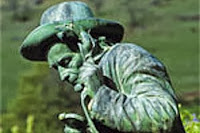It seems like such a little act: lighting a candle. But I have discovered in that act much to meditate upon.
 As the year heads into its last few months, more tiny flames are lit around the world as particular religious festivals arrive: Diwali, Hanukah, Christmas, even the newcomer Kwanza. All these celebrations light candles in some form as part of their ceremonies. Sometimes the wicks being lit are at the tip of hard candles; sometimes in a tiny cup of liquid. But the visual effect is the same. And it is beautiful.
As the year heads into its last few months, more tiny flames are lit around the world as particular religious festivals arrive: Diwali, Hanukah, Christmas, even the newcomer Kwanza. All these celebrations light candles in some form as part of their ceremonies. Sometimes the wicks being lit are at the tip of hard candles; sometimes in a tiny cup of liquid. But the visual effect is the same. And it is beautiful.In the northern hemisphere, the lighting of candles on those holidays late in the year carries an added spiritual meaning through the warmth the candles bring in cold weather. But even when those religious holidays are practiced in the southern hemisphere, with days getting longer, candle lights can bring a soft yellow glow to what was darkness. Although I am not a Roman Catholic, I have (as long as I can remember) found pleasing any pictures of Catholics lighting candles in a sometimes dim sanctuary, often accompanied by private prayers.
Before electricity came to our modern world, candles were used where today we use tiny light bulbs. I feel nervous when I see pictures of some Europeans lighting candles on the branches of evergreen Christmas trees. And I know the firefighters at my local fire-department can sleep easier knowing that electric lights decorate our trees in the U.S. But we still desire to light candles in other ways during these festive months.
Before our petroleum age, the material for candles was wax from bees or tallow from sheep or cattle. We might do well to recognize the flame as also being a gift from Nature.
Scientists who work in the area of evolutionary psychology try to project their thoughts back upon the path of human evolution. Certainly a significant step in that story would have been being able to start a fire. The European cultural heritage expresses how momentous that discovery was with its mythological story of Prometheus, who steals fire from the gods. In the playwright Aeschylus's adaptation Prometheus Bound, Prometheus is also viewed as being the bringer of civilization. But the god Zeus knew all too well how dangerous humans could be without bounds. And so, Prometheus is bound to a rocky mountain as punishment.
That danger of possessing fire is why my reflections upon candle-lighting have led me to see it as an example of behaving in a restrained, respectful manner. In humankind's use of candles, we have found a way to handle fire in a controlled way. If in mythology fire brings civilization, can lighting a candle be a civilizing act today? In our religious and spiritual lighting of candles, can we—instead of fanning the flames of anger in ourselves and others—turn our hearts toward worship?
The commonality across faith-traditions of lighting candles (whether in sticks or cups of liquid) might enable us to share in the emotions of Howard Thurman, even if our faith-tradition is non-Christian, or if we have none. He writes in part:
Do you light candles on particular occasions? When? What feelings does it bring?
(The painting of Prometheus by Jan Cossiers is in the Public Domain.)

























